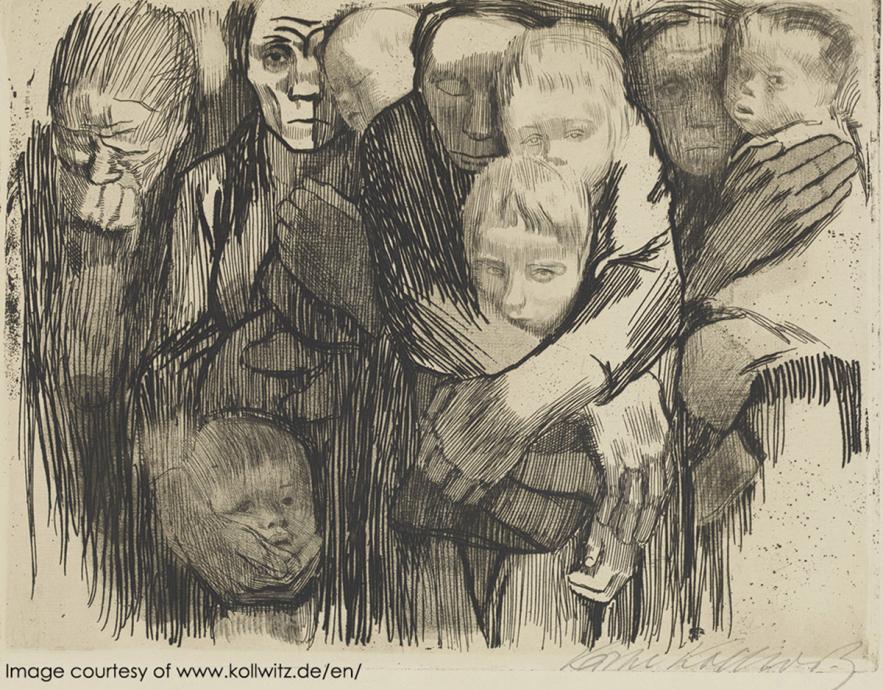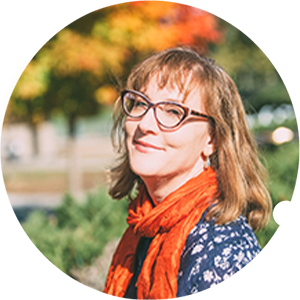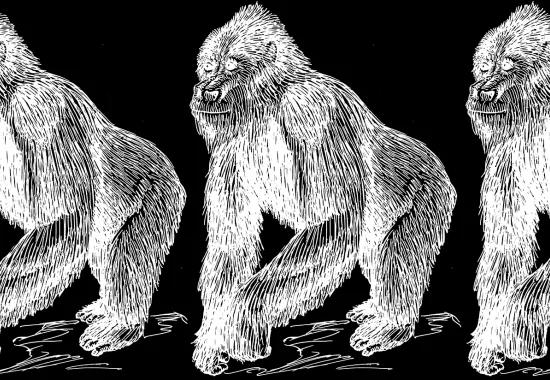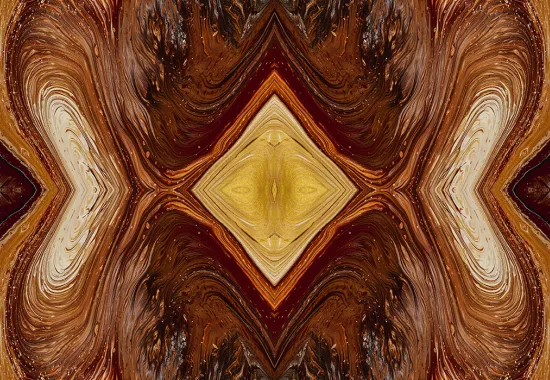Mother-Loss
The heart remembers everything it loved and gave away,
everything it lost and found again, and everyone
it loved, the heart cannot forget.
– Joyce Sutphen, “What the Heart Cannot Forget”
Käthe Kollwitz’s lithograph The Mothers makes me long for a child. The German artist, working during both world wars, depicts a group of mothers standing in a huddle; there are babies, toddlers, and young children in the group, safely protected behind the heavy limbs and hands of their mothers. The mothers merge, as if they are one mass force of protection and sorrow. One mother tightly grips her two children with her arms; her head falls into the taller child’s head, her eyes close as if she is relieved or weary. It is a portrait of desperate mother-love. Even though this 1920 lithograph wasn’t created to promote motherhood—it was used as an anti-war poster—it makes me think that motherhood is a primordial part of being a woman. The way these mothers interact with their children is deeply moving, pointing to an intense connection between them.

Image: Mothers, rejected first version of sheet 6 in the series »War«, 1918, line etching, sandpaper and soft ground with imprint of laid paper and bundle of needles, Kn 137 II (c) Käthe Kollwitz Museum Köln
In a bronze sculpture of the same composition done in 1937, the effect is even more dramatic. The Tower of Mothers shows a group of mothers standing in a circle, facing outward with their arms joined. Their bodies form a protective barrier against anything that would try to harm their children. It could be war, hunger, or poverty. Even the name, Tower of Mothers, evokes the impression of a formidable force. Nothing will come between them and their children.
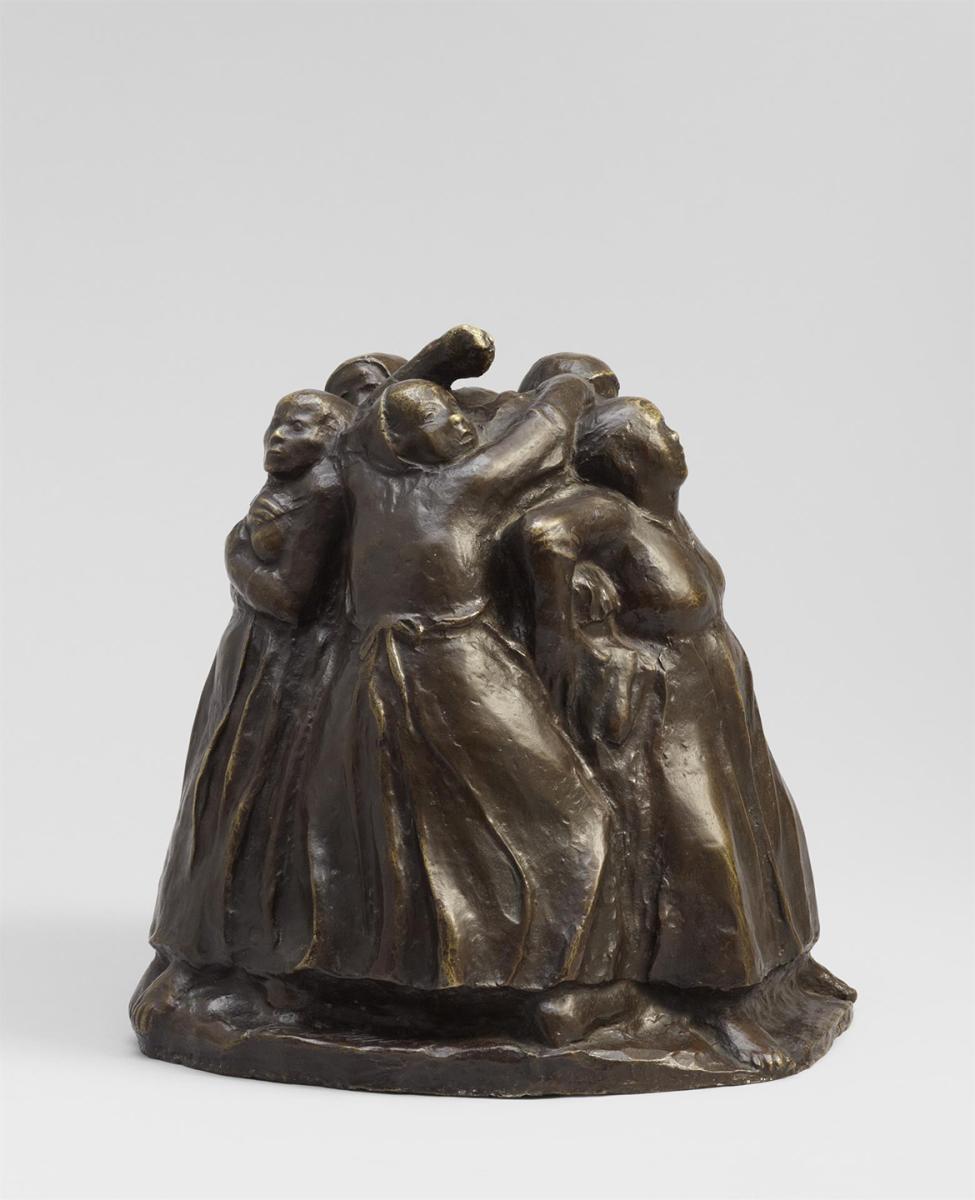
Image: Tower of Mothers, 1937_1938 Bronze, Seeler 35 II.B.1 (c) Käthe Kollwitz Museum Köln
As I circle this sculpture in the Käthe Kollwitz Museum in Berlin, this impenetrability draws me in. The force of the mothers’ love oozes out of this solid mass of metal. It pulls at my heart and makes me want to have a child. Until then, I’d been ambivalent about motherhood, thinking I could take it or leave it. After seeing Kollwitz’s work, I wasn’t sure I could be so cavalier. I begin to wonder if I am missing out on one of life’s great experiences.
At the time Kollwitz sculpted it, the piece was to be part of an exhibition of works from artists in the Klosterstrasse neighborhood in Berlin in the late 1930s. Kollwitz’s friend and fellow artist Otto Nagel wrote: “It is a strong, self-contained work, compactly designed, in which she used a motif she had often depicted graphically, mothers defending their children. These women are militant, full of determination, ready to protect small and helpless creatures.” The Nazis removed the piece from the exhibition, saying that mothers had no need to defend their children because they lived in the era of the Third Reich, where the State protected children. Nagel wrote: “This must surely be the height of cynicism, when one realizes that only a little later, these same brown-shirted barbarians drove millions of young people ruthlessly to their death.” By the time she completed this work, Kollwitz had already lost a son in World War I and would lose her grandson in World War II.
Her work aptly puts an image to the feminist maxim that says the personal is political. Kollwitz is primarily known for her raw depictions of war and suffering, but her portrayals of motherhood are what I find gripping. The emotional weight of her work catches me and makes me ponder the joy and sorrow of motherhood. Mothers dominate her work. They are protectors, sufferers, and nurturers; they are beings whose motherhood seems to fuel a supernatural kinetic energy—an energy crazy with life and loss.
In another sculpture, simply titled Group, Kollwitz depicts a mother surrounding, almost engulfing, her children with her arms. The mother is sitting with her legs bent up, her back hunched over, and her face partially buried in the faces of her two children. The children, a baby and a toddler, sit cradled in her arms, which reach around them so that her hands touch in front of her. Certainly this could be a mother simply expressing love to her children. But there is something more to this work. This is a woman who is desperate for her children, so much so that she wants to bring them back into herself where she can keep them safe. Psychotherapist Janna Malamud Smith describes this type of mother-love: “When a mother attaches to her children, her love encircles them like a web of filaments that reach across physical separateness and link her feelings—her very nerve endings—to their safety and well-being.”
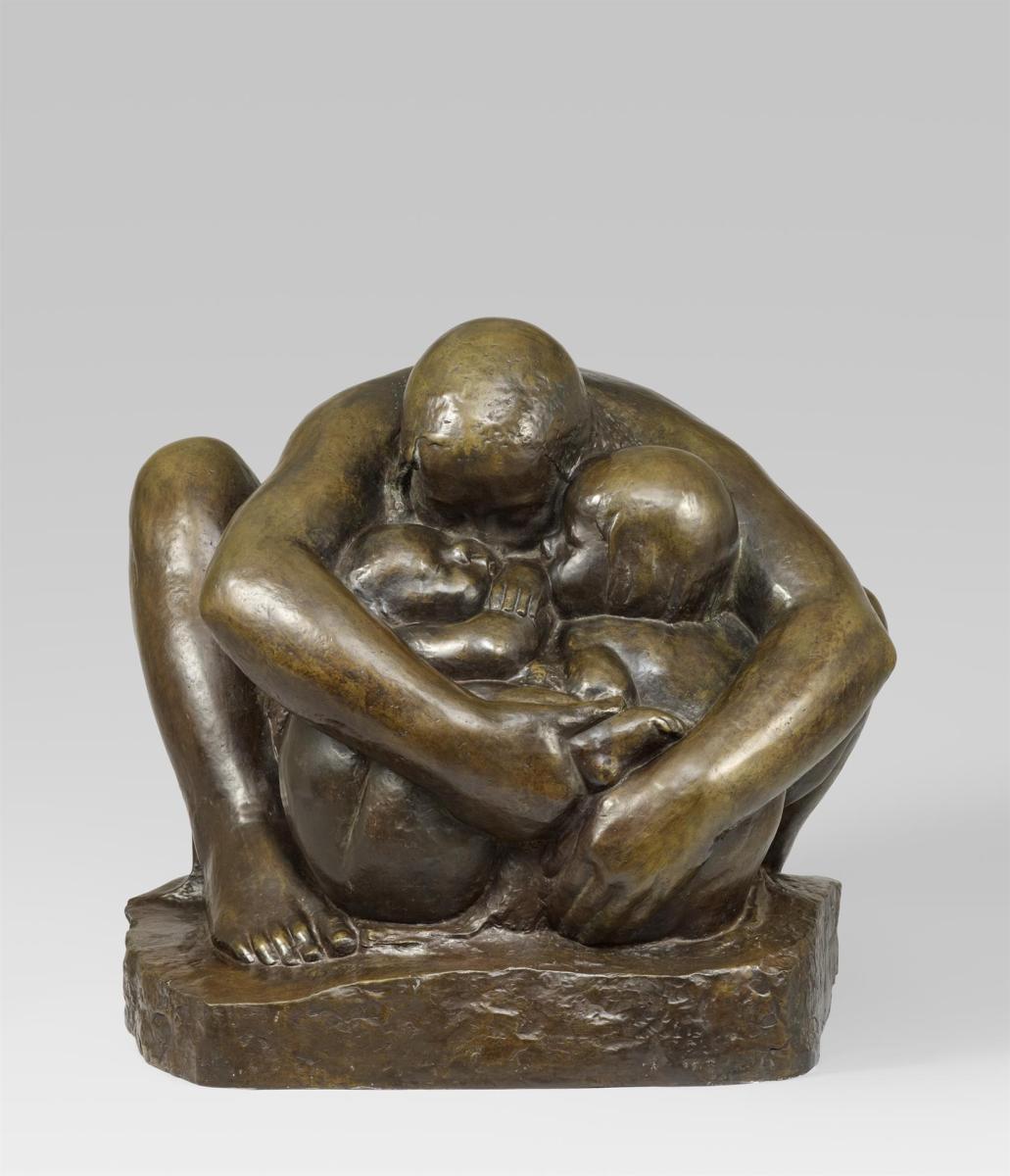
Image: Mother with two Children, 1932-1936 Bronze, 760 (h) 850 (w) 800 (d) mm, Seeler 29 I.B.6. (c) Käthe Kollwitz Museum Köln
Does motherhood give a woman an impenetrable bond to another human? Kollwitz makes me think so. That bond also brings intense vulnerability. Vulnerability and impenetrability are at war in her mothers, contradictory forces that fight for dominance, with little uncontested ground.
In my own ambivalence about motherhood, I’d let time and circumstances, instead of desire, determine my fate. I married in my mid-thirties and never considered having a child before then. My childless state was not the norm in a world where motherhood seems inevitable. But I never had the intense longing for a child that so many women described to me. Something changed when I met Kollwitz’s mothers. I wanted to have the connection that I saw displayed in these works, that intense, all-consuming kind of love that makes everything else seem unimportant.
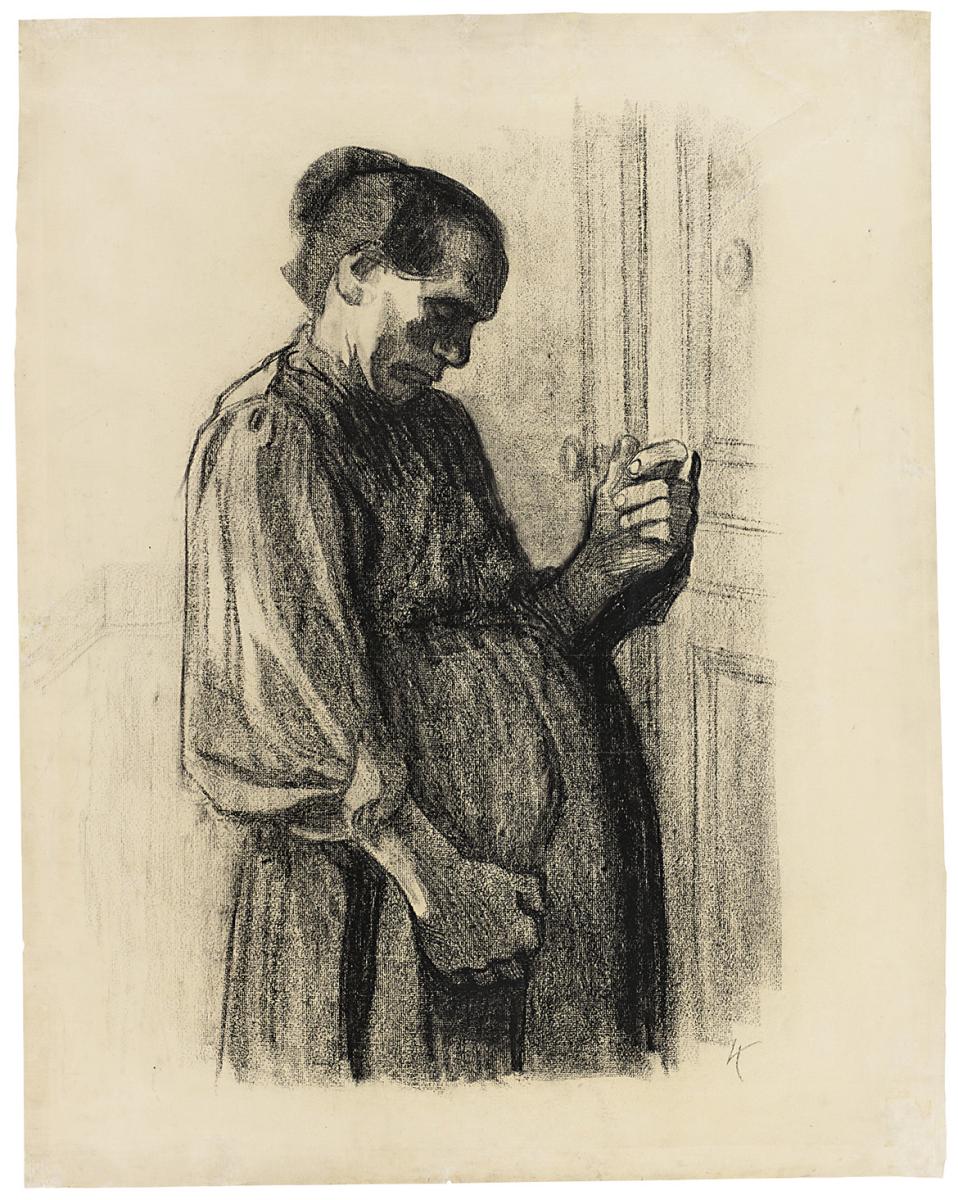
Image: At the Doctor’s, sheet 3 of the series »Images of Misery«, 1908/1909 Black crayon on Ingres paper, NT 475 (c) Käthe Kollwitz Museum Köln
Kollwitz uses mothers to convey the deepest human emotions and experiences: anguish, hopelessness, joy, weariness, peace, anger, relief, fear, resignation, emptiness, and love. These are works in various mediums: charcoal drawings, lithographs, etchings, and woodcuts. Their somber subject matter fuses with Kollwitz’s colorless depictions, black and white contrasting sharply with each other. In the dark and detailed lithograph Poverty, a mother leans over her small child’s bed, her head in her hands, her despair clear. Another, Portraits of Misery, III, a pregnant woman is shown in profile, knocking on a door. She could be seeking help in the form of money, shelter, or food. In the print Death and the Woman, a naked, muscular woman is struggling against the figure of death who grasps her from behind, his skeletal frame starting to wrap around her, as her young child reaches up at her chest, trying to climb up her body. The rough woodcut Hunger shows dark skeletal figures, a mother with her bony hand covering her upturned face, while on her lap lies a dead child. In the woodcut The Victim, a naked mother holds up her newborn baby; they stand against a dark circular background that engulfs them.

Image: Death seizes a Woman, sheet 4 of the series »Death«, 1934 Crayon lithograph, Kn 267 a (c) Käthe Kollwitz Museum Köln
These mothers make me gasp in astonishment and sorrow. That pain is at once real and gripping. Malamud Smith writes, “[M]other love is so strong that it reaches beyond the human into some other realm of feeling; its intensity has a life of its own, which overtakes women and creates an almost incomprehensible state of mind.” Kollwitz captures this intensity with a sparseness befitting the desperate sadness of her characters.
Her work isn’t what I would call conventionally beautiful. Most of her prints are shades of black and white; she was mainly a graphic artist. She gave up studying painting early in her training, saying that color was her stumbling block. In her work few background flourishes call my attention from the central subject of her works; there are no colors to get lost in; my eyes don’t move around the images, but beam into the center, into the face of the mother, the central being, who pulls me in. Her sculptures likewise are bare, providing just enough shapes, hollows, and ridges to create heavy forms, weighted down with life’s sorrows.
One of Kollwitz’s favorite artists was Michelangelo. She made a drawing of The Pieta, following Michelangelo’s famous sculpture in the St. Peter’s Cathedral in Rome, but her rendition is starkly different. Michelangelo’s Pieta is a work of devotion; Kollwitz’s, a portrait of a mother and child.
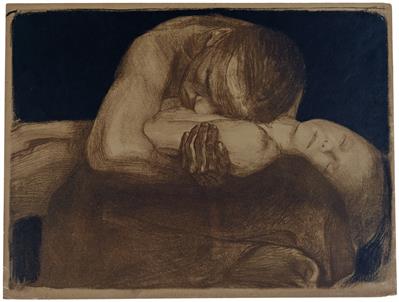
Image: Woman with dead Child, 1903 Line etching, drypoint, sandpaper and soft ground with imprint of ribbed laid paper and Ziegler's transfer paper, Kn 81 VIII a (c) Käthe Kollwitz Museum Köln
Kollwitz’s Pieta draws on my emotions much more heavily. The mother is large and almost grotesque; she has none of the loveliness of Michelangelo’s Mary. She bends her body over to grasp the body of her dead child. Her head rests on his chest while her muscular arms and manly hands cling to the lifeless body. Except for a cloth that drapes the woman’s lap, all other elements that might distract me from the mother’s loss have been removed. This is one of the few works where Kollwitz used color, but even so, the color is minimal. The background is dark turquoise, and she uses sparse strokes to highlight lines of skin and muscle. Heavy, dark lines represent the mother’s grim-set mouth and closed eyes. This portrayal is one of sorrow and devastating, lasting loss.
The emotion in her Pieta nearly scares me away from motherhood. The depth of pain that this mother feels is something I don’t know if I can endure. When I contemplate having a child of my own, I wonder if this love will break me as it has broken Kollwitz’s mothers.
I struggle to live my life without fear, but it’s there. Possible dangers abound—illnesses, accidents, and all manners of harm seem to be lurking around every corner. Motherhood magnifies this fear. Malamud Smith writes, “…there is an enlarged sense of vulnerability, personal and social, created by becoming a mother—and accepting the intimate mission of keeping a dependent being alive.” We are all vulnerable, but motherhood somehow puts that vulnerability right in front of you; it makes mortality more vivid. I’ve pondered this for years and even after finally being in the position to have a child, I wondered if it was something I could do. I’ve weighed what I might miss by never becoming a mother against what I would lose if something happened to my child. I am starting to believe that motherhood may be worth it, that the fear may be overshadowed by joy.
Kollwitz has trapped me with tragedy, snared me with sorrow. When her parents asked her why she portrayed the dark side of life, she had no reply. She writes in her diary, “The joyous side simply did not appeal to me.” Besides living through her own suffering, Kollwitz felt the sadness and suffering of the people around her. She observed many poor mothers and their children in her husband’s medical clinic, which was located in a working-class neighborhood in northeastern Berlin. His patients were tailors and their families. Her husband’s practice was one of the first types of socialized medicine to be implemented in Germany and was a precursor of our modern medical insurance.
Many of the women who came to her husband’s clinic were the models or inspiration for her work. They weren’t her subjects merely because they would help her create a political message; she said she chose them because she found them beautiful. In her diaries, she writes of being grieved and tormented by the problems of working-class women. They were poor. Some had been abused by their husbands. Their children were sick. They were not happy women. These women connected her to a life she considered real. “…[P]ortraying them again and again opened a safety-valve for me; it made life bearable.” She connected with them in her work through her experience of motherhood; it’s the same theme that I find so appealing. Perhaps portraying issues through motherhood makes them more palatable, more easily grasped by anyone. Everyone has had a biological mother or father, many people are parents themselves; people looking at her work understand the power of human connection. Biographer Carl Zigrosser said that she looked at life not as a woman, but as a mother: “Her allegiance was not to Aphrodite but to the Eternal Mother.”
Kollwitz saw the world through the dual lenses of mother and artist. With her work, she merged the two. She watched other mothers suffer because of social ills like poverty, exploitation, and war.
Kollwitz was tangentially a part of an art movement, Expressionism, that found a home among German artists. Expressionists distorted or caricatured their subjects in ways to “express” an emotion, like love, admiration, fear, or sadness.
Expressionist art was often not “beautiful” art. Expressionists showed their subjects as “ugly” if that would convey a message. As art historian E. H. Gombrich explains: “[T]he Expressionists felt so strongly about human suffering, poverty, violence and passion, that they were inclined to think that the insistence on harmony and beauty in art was only born out of a refusal to be honest.”
Expressionism aroused the anger and vindictiveness of the “little man,” Gombrich says. When the Nazis came to power, they banned this type of art and exiled those artists or forbade them to work.
For Expressionists, the message became more important than the subject, so artists began experimenting with the effects of tone and shape at the expense of the subject matter. This is where Kollwitz differed from her contemporaries; she wanted her art to be accessible to anyone. She wanted her art to change the world. Art historians Ann Sutherland Harris and Linda Nochlin write, “…she increasingly came to see Expressionism as a rarefied art of the studio, divorced from social reality. ‘I am convinced,’ she wrote in a diary of 1908, ‘that there must be an understanding between the artist and the people such as there always used to be in the best periods in history.’ ” Kollwitz insisted on a social function of art. She wanted her art to connect with the people who looked at it. She certainly succeeded with me. As I stared at her mothers in that Berlin gallery, I found myself nearly overtaken by the emotion of her work.
Kollwitz’s art depicts not only the world she saw, but her attempts to affect it. “She was a searcher to the end,” Zigrosser says. She wanted her art to change the despair and destruction surrounding her. In her diary she wrote: “One can say it a thousand times that pure art does not include within itself a purpose. As long as I can work, I want to have an effect with my art.” Her relentlessness to make a difference with her art changed me, slowly moving me from ambivalence to desire.
Kollwitz saw the world through the dual lenses of mother and artist. With her work, she merged the two. She watched other mothers suffer because of social ills like poverty, exploitation, and war. She suffered as a mother: Her son and grandson were casualties of two different wars. It is this loss that brings out the depth of feeling in her work; it’s a special kind of mother-loss, a grief that is perhaps harder to bear than other types of grief. In her diaries, she writes of how her work connected her to her son who had died, and the grief pushed her on to work: “I might make a hundred such drawings and yet I do not get any closer to him. I am seeking him. As if I had to find him in the work.”
She tapped into a collective loss that transcended class, nationality, ethnicity, and generations. Looking at her work, I wonder, can motherhood make you more compassionate? More altruistic? Less myopic? Kollwitz, with what Nagel calls her “all-embracing mother love,” makes me think so. Of that love, he writes: “It hovers about her work like a symbol of goodness, it gives us hope that we shall find a refuge.” A refuge in suffering together, in solidarity, in naming the pain.
I danced around this pain of mother-loss without having children, fearing losing something I didn’t even have. Yet when I look at Kollwitz’s mothers, I feel their overwhelming loss, their fear of harm. I slowly begin to think that perhaps, just perhaps, it is a worthwhile sacrifice—my fear for indescribable love and connection.
Motherhood asks you to care about another; to sacrifice for someone else’s well-being. Perhaps it feels more natural doing this for one you brought through the birthing process or waited for months to adopt. Perhaps motherhood provides women with a sense of purpose. Simone de Beauvoir wrote in Second Sex: “Like the woman in love, the mother is delighted to feel herself necessary.” Kollwitz’s mothers are more than necessary; they are all about sacrifice. But it’s more than a sacrifice of time or work or energy. It is a loss of emotion, of self, of control; it is the willingness to lose yourself in another wholly dependent being, a willingness to risk the loss but a hope that you won’t have to. It is accepting pleasure and pain, delight and sorrow. Maybe these tradeoffs shouldn’t stop me; in fact, maybe they’ll make my life richer.
Motherhood was one way for Kollwitz to find a connection through her art. Through her mothers, Kollwitz shows every emotion, appeals to the basic urges of human experience. She wrote: “But the good artists who follow after genius—and I count myself among these, have to restore the lost connection once more. A pure studio art is unfruitful and frail, for anything that does not form living roots—why should it exist at all.” Kollwitz made living roots through her mother art.
And that is how she found me, enticed me with a desire to love more deeply and open myself up to the pain and sacrifice of motherhood. I think of her mothers now as I rock my baby daughter to sleep, marveling at her life and the way she’s filled my heart. And when I worry about how I will take care of this child, I mentally revisit Kollwitz’s sculpture in that Berlin museum, to the place where I was first ensnared, to the place where Kollwitz’s living roots grew out of her mothers, through the base of her sculpture, across the floor, and around my feet. They twined around my legs, up through my womb, and tightly circled my heart. They slipped up around my neck and into my ears, and whispered, “Yes!”
Recommended
Schizophrenic Sedona
Recense (realized)
Notes on Hands


